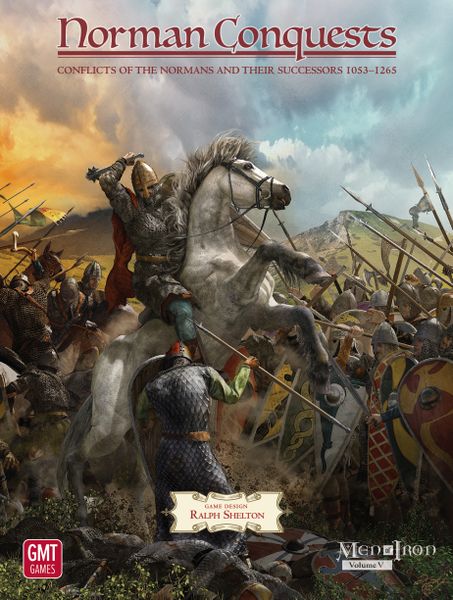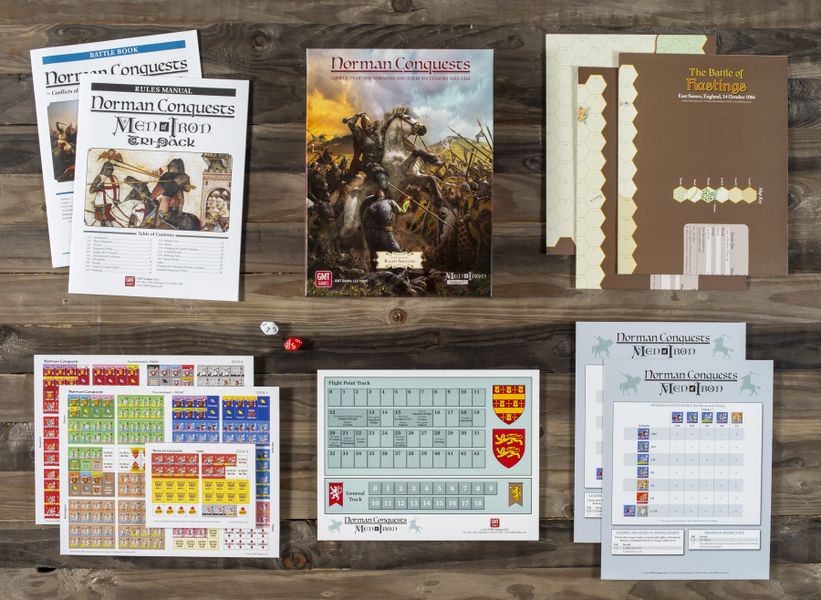GMT Games - Norman Conquests
,gravity=Center,allowExpansion)
,gravity=Center,allowExpansion)
Collect 130 Everyday Rewards points
FREE SHIPPING when you spend over $100
Exclusive to products sold by Good Games
,gravity=Center,allowExpansion)
,gravity=Center,allowExpansion)
Collect 130 Everyday Rewards points
FREE SHIPPING when you spend over $100
Exclusive to products sold by Good Games
The Normans, and their successors, had a large impact on history. Normans, from Nortmann (northman), were originally Viking raiders that settled in what would now be northern France.
Normans gained territory as far away as southern Italy and Sicily, and modern day Syria. They were Crusaders, they were Kings, they were princes, and they were scoundrels. They began as raiders from the north that fought on foot and transformed themselves into Dukes, Kings, and princes that fought from horseback.
How many games include a battle with a Papal army? Very few, so Norman Conquests visits Italy and the Norman Count of Apulia fighting with, and capturing, the Pope. Stretching the definition to include the Norwegian King Harald (III) Hardrada (undoubtedly a northman) and his invasion of England allows us to include all three battles for the throne of England in 1066, including the most famous Norman William the Conqueror and his invasion of England. Next we catch up with two sons of William I, the Duke of Normandy and the King of England, feuding over his lands years after his death. We end with the Baron’s War between William I’s great-great-great-grandson Henry III and his barons who were led by Simon de Montfort.
The battles include:
Time Scale: 1 to 5 hours
Map Scale: about 110 yards per hex
Unit Scale: about 250 men
Number of Players: 1-2
COMPONENTS
Designer: Ralph Shelton
Developer: Jason Lindsay
Counter Art: Mike Lemick and Charlie Kibler
Map Art: Charlie Kibler
Good Games uses Australia Post for shipping of orders across Australia as they have the widest reach and offers our customers conveniences like Parcel Lockers, Parcel Collect, and mail redirection.
Orders are shipped using Australia Post eParcel Post.
If you are unavailable at the time of delivery re-delivery fees may apply.
At Good Games, we want our customers to be completely satisfied with their purchases. If you have any concerns regarding your purchase, please contact us.
CHANGE OF MIND
We are not required to provide a refund or replacement if you change your mind, however in most cases we will be happy to as long as the product is sealed in their original packaging, unused, unopened and in brand new resalable condition and it is within 30 days of your original purchase (or delivery date if shipped)
Please note you would be responsible for returning the product, as well as the original cost of shipping.
FAULTY PRODUCTS
If a product that you have purchased from one of our stores does not meet expectations of the item as it was advertised, or the product is faulty, then please return the product to where you made the purchase for an exchange or refund, in accordance with Australian Consumer Laws.
You can choose a refund or exchange if an item has a major problem. This is when the item:
Alternatively, you can choose to keep the item and we will compensate you for any drop in value.
If the problem is not major, we will repair the item within a reasonable time. If it is not repaired in a reasonable time you can choose a refund or replacement.
Please keep your proof of purchase – e.g. your receipt, invoice or confirmation email.
GTIN: 817054012671
Estimated Delivery Time Frame:1-14 Business Days
Ask a Question About This Product
Reference ID: 15529704